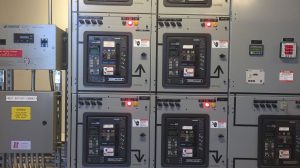
One of DOSE Engineering’s data center projects
When thinking about what your data center needs to do, you may be focused on the software security side of things: protecting business and client data, and making sure there are no disruptions to availability.
However, when designing a data center environment, there are many other factors to take into consideration. Your mechanical and electrical engineering (MEP) team must work together with your architect and construction manager if you are building from scratch, or your site selection team if you are looking at pre-existing space. Most importantly, your MEP team must work with your IT team.
Mechanical and Electrical Engineers can help with site selection, by evaluating several factors including square footage, usability of space, existing site mechanical and electrical system limitations and other constraints, as well as fire risk and scaling opportunities. They can help with planning how best to use the space, including the selection and layout of equipment for overheating and fire protection while maximizing usable floor area for data racks.
Your MEP team can evaluate the limits of the power available in a pre-existing space, and discuss potential upgrades to the infrastructure to provide additional power. They can also advise you on the most up-to-date systems to cool your data center, as well as control humidity.
Your MEP team can help you strategize around airflow and air containment. They’ll design a plan to help maximize the use of cold air coming into the center, and efficient placement of fans to exhaust hot air from individual pieces of equipment and the space, keeping a consistent room temperature for your equipment to operate at as near-ideal conditions as possible (hot aisle/cold aisle strategy). They can advise and install modern computer room air conditioner units (CRACs), and innovative green solutions for your data center.
Beyond equipment, they can advise as to installation of filler panels, the potential benefits of sealing equipment, and various options for cable management, all of which will reduce leaks.
Working with your IT personnel to understand what types of equipment are currently being used, and what replacement and scaling is anticipated in the future, the MEP team can give input on the design of racks, aisles and placement of equipment, including how to integrate free-standing equipment. The MEP team can also provide input on the best strategy for scaling by adding racks to a row or aisle. They can help design the center in a modular fashion, leaving room for growth and change.
A good MEP team can advise you on how to take advantage of the most efficient servers on the market, which use less power, especially when idle. They can offer options for battery backups and other power redundancy methods to ensure that even in a power failure situation, your data center will have access to electricity. They’ll be able to weigh in on the density of equipment around power supplies. They can also give input on how ceilings, floor space, columns, light fixtures can be worked around.
These efforts will result in reduced energy consumption and consistent operating costs. Only when you have consulted with an MEP team will you have a true grasp of the true costs and build-out schedule for your new or upgraded data center.
